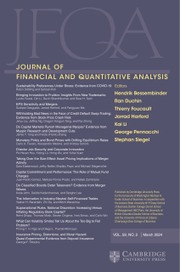No CrossRef data available.
Article contents
Price Discovery from Offer Price to Opening Price of Initial Public Offerings
Published online by Cambridge University Press: 03 January 2025
Abstract
We examine the preopening process and price discovery from the offer price to the first open price in initial public offerings. The extent of price discovery during preopening is influenced by firm characteristics and preopening attributes, such as volume of shares executed in preopening, canceled orders, order imbalance, and changes in indicative price. Institutional investors cancel 4 orders for every executed order. Each phase of preopening contributes to incremental price discovery. In “hot” IPOs, almost all price discovery processes occur during preopening, whereas in “cold” IPOs, half of the price adjustment occurs after the market opens.
Information
- Type
- Research Article
- Information
- Journal of Financial and Quantitative Analysis , Volume 60 , Issue 7 , November 2025 , pp. 3443 - 3474
- Creative Commons
- This is an Open Access article, distributed under the terms of the Creative Commons Attribution licence (http://creativecommons.org/licenses/by/4.0), which permits unrestricted re-use, distribution and reproduction, provided the original article is properly cited.
- Copyright
- © The Author(s), 2025. Published by Cambridge University Press on behalf of the Michael G. Foster School of Business, University of Washington
Footnotes
Aggarwal acknowledges support from the Robert E. McDonough professorship at Georgetown University’s McDonough School of Business. We thank anonymous referees, Kathleen Hanley, Jarrad Harford (the editor), Michelle Lowry, Jay Ritter, Chester Spatt, Donghang Zhang, and seminar participants at Georgetown University, as well as conference participants at FIRS, for their helpful comments.

